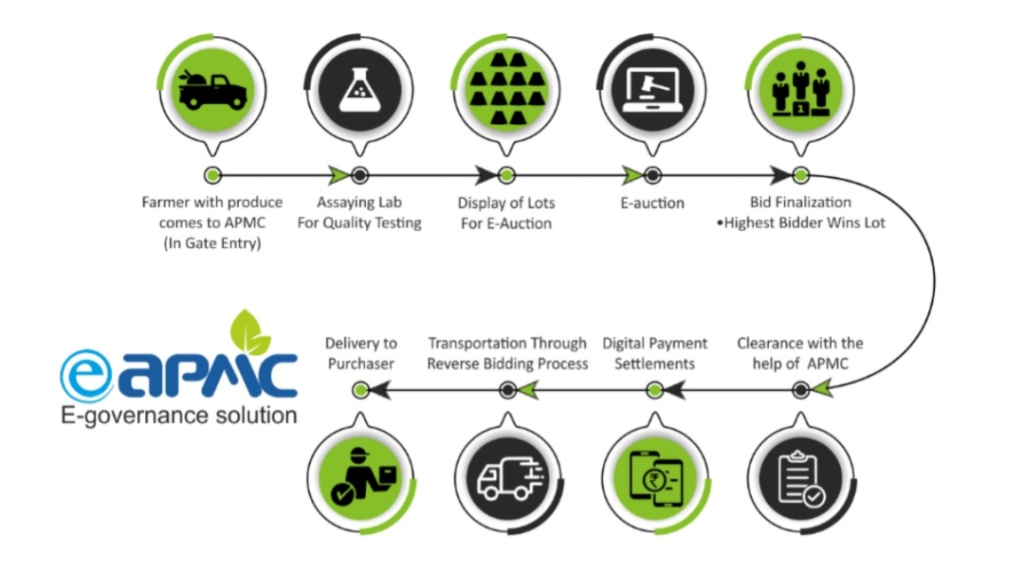
The story of APMC
An Agricultural Produce Market Committee (APMC) is a marketing board set up by state governments in our country to make sure farmers are protected from exploitation by big market players, as well as making sure that the farm to retail price spectrum does not reach extremely high levels. APMCs are monitored by states via their adoption of a Agriculture Produce Marketing Regulation (APMR) Act.
Until 2020, the first sale of farm produce could take place only at the mandis of APMCs. But after 2020, the passing of the Farmers’ Produce Trade and Commerce (Promotion and Facilitation) Act, lets the farmers to sell in markets besides the APMC mandis as well as in markets across different states of India.

Before independence in 1947, the most important concern of Government policy related to agricultural marketing was to keep the prices of food for the consumers and farm raw materials for the industry under check. But, after independence, it became a necessity to protect the interest of farmers and to provide them low prices to increase the production of farm goods. Common all over the nation were issues of local money lenders extracting high amounts of food grains from the agriculturist, at low prices, as interest. Identifying the issues that farmers faced—such as losses in the form of undue low prices, high costs of marketing, and considerable physical losses of the crops in the agricultural marketing system—the Indian Government implemented many compulsory rules in hopes of setting up a procedure to regulate the market conduct. Monitoring and growth of primary agricultural harvest markets was taken up as an organisational innovation, and building of well laid out market yards was considered as an important requirement for monitoring the practices in primary wholesale markets.

History
The idea of an agricultural produce market regulation programme in our country dates back to the British era.: Raw cotton was the first agricultural crop to attract the attention of the Government because of the need of British rulers to make available the supplies of cotton at low prices to the textile mills of Manchester (UK). In consequence, India’s first regulated market in Karanja was set up in 1886 under the Hyderabad Residency Order, with the first law being the Berar Cotton and Grain Market Act of 1887, which authorised British inhabitants to proclaim any place in the allocated district a market for sale and purchase of agricultural crops and form a committee to overlook the monitored markets. This Act became the basis for enactment in other regions of the nation.
An essential landmark in the agricultural marketing scenario in the nation has been the suggestion of the 1928 Royal Commission on Agriculture for monitoring of marketing practices and setting up regulated markets. One of the steps taken to enhance the circumstances was to monitor the trade practices and to set up market yards in the rural areas. In continuance, Government of India created a Model Bill in 1938 and distributed it to all the states; but, not much improvement was made until India’s independence.
During the 1960s and 1970s, most of the states enacted and implemented the Agricultural Produce Markets Regulation (APMR) Acts. All primary wholesale assembling markets were brought under the extent of these Acts. Well laid out mandis and sub-yards were built and, for each market region, an Agricultural Produce Market Committee (APMC) was created to frame the regulations and implement them. Hence, the organized agricultural marketing came into being through monitored markets.
In 2015, the year’s Union Budget recommended to form a United National Agriculture Market with the assistance of state governments and NITI Aayog.
Reforms
Reforms have been made by the Government of India in the form of three acts in 2020:
The Farmers’ Produce Trade and Commerce (Promotion and Facilitation) Act the Farmers (Empowerment and Protection) Agreement on Price Assurance and Farm Services Act; and the Essential Commodities Amendment Act the ascendence of middlemen in APMCs and form a free market. While cartelization has been a major issue in APMCs, these bills have been denounced by the farmers themselves due to the trepidation that these legislations will cause humiliation of APMCs and in the end Minimum Support Price will be dissolved.
This has caused protests by farmers in India especially in Punjab, Haryana and west parts of Uttar Pradesh.

Overview
APMCs function on two ideals:
Making sure that farmers are not exploited by mediators (especially money lenders) who force farmers to sell their crops at the farm gate for very less prices. All food produce should initially be brought to a mandi and then sold through a bidding system.
Each state that functions APMC mandis set up their markets in different regions inside their borders, geographically dividing the state. Farmers are required to sell their crops via bidding at the mandi in their area. Traders are required to have a license to function inside the mandi. Wholesale and retail traders (e.g. shopping mall owners) and food processing companies are not allowed to buy produce straight from a farmer.
APMC Model Act, 2003
Some of the important characteristics of the APMC Model Act 2003 include:
Promoting contract of farming model. Distinctive market for perishables letting farmers and private people to establish their own market. Ease of licensing norms. Single market fee APMC incomes to be utilised for upgrading market infrastructure.
But, not all states have legalised the bill. Some states have passed but neither formed regulations nor informed the public about it. Thus, inter-state obstacles continue.
APMC by state
Madhya Pradesh
The Government of Madhya Pradesh has taken several steps so that agriculturists may get a better price for their crops.
Karnataka
The Government of Karnataka has made APMCs in many areas to let farmers to sell their crops at decent prices. Different APMCs are allotted a market where traders and other marketing agents are given stalls and shops to buy farm harvest from farmers. Farmers can sell their produce to agents or traders under the regulation of the APMC.
Prior to 2020, Farmers couldn’t sell produce outside the APMC process. The APMC system made farmers at risk to traders’ and marketing agents’ price manipulations. The Government of India has tried improving the APMC Act to benefit all parties involved.
In 2020, the Government of Karnataka passed the The Karnataka Agricultural Produce Marketing (Regulation and Development) (Amendment) Bill, 2020, which lets farmers to trade their harvest anywhere without the involvement of APMCs. It also allowed Food processing companies to buy harvest directly from agriculturist.
Maharashtra
The Maharashtra State Agricultural Marketing Board (MSAMB) runs 295 APMCs in the state of Maharashtra, under the APMC Act executed by the Government of India. In July 2016, the Maharashtra Government removed fruits and vegetables from the extent of the APMCs, urging farmers to directly bring their crops for sale in Mumbai. The government has authorised 148 Direct Marketing Licenses, of which 91 are for perishable items like fruits and vegetables. The APMC in Pune, in the meantime, requested the farmers from the state as well as from other state to bring their harvest to the market and sell those directly.
Tamil Nadu
In Tamil Nadu, the Tamil Nadu State Agricultural Marketing Board, conveniently running since 1977, is the regulatory board for agricultural markets. 21 market committees are set up for every notified region, and 277 monitored markets are working under these committees for improved rules of purchasing and selling of agricultural products.
Andhra Pradesh
The Andhra Pradesh (Agricultural Produce and Livestock) Markets Act Government Order was passed in the Andhra Pradesh vidhan sabha in 1966, and was amended again in 1969.
Written by- Aakanksha Chaturvedi
LITERARY SOURCES
https://en.wikipedia.org/wiki/Agricultural_produce_market_committee#:~:text=An%20Agricultural%20Produce%20Market%20Committee,not%20reach%20excessively%20high%20levels.
https://byjus.com/free-ias-prep/apmc/
https://www.jagranjosh.com/general-knowledge/agricultural-produce-market-committee-apmc-1604575739-1




